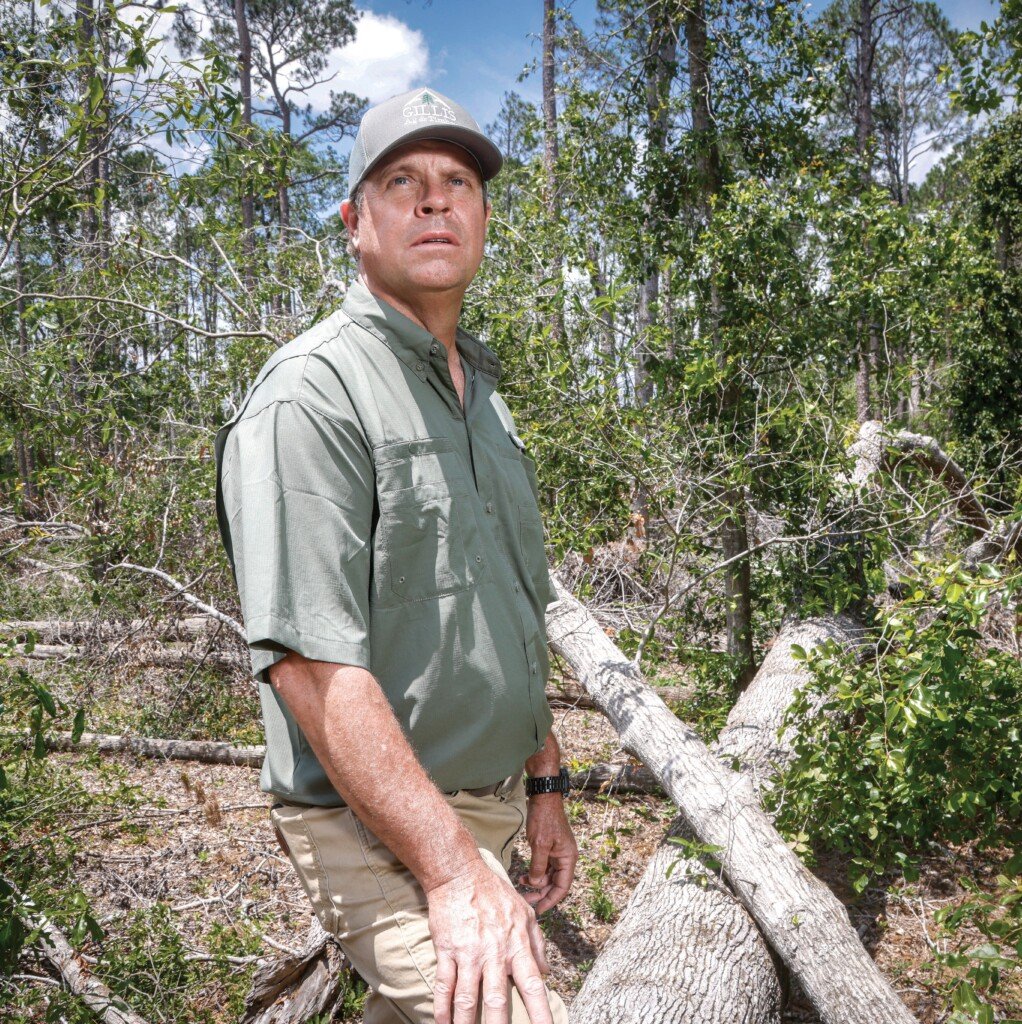Agriculture Moves Beyond the Earth

Leading the Charge: Grant Anderson, founder and operations manager, Better Fresh Farms in Metter. | Photo credit: Frank Fortune
Georgia’s high-tech greenhouses and vertical hydroponic farms are a growing alternative to traditional farming of crops like greens, herbs, tomatoes and mushrooms.
In 2015, Grant Anderson was becoming increasingly dissatisfied with his chosen career path. Since his graduation from Georgia Tech almost a decade earlier, the Effingham County native had been working in the financial industry in “some shape or form,” he says. “I didn’t find a lot of satisfaction there, and I wasn’t sure where my career was headed. I didn’t feel a lot of passion for anything I was working on.”
Then one day while looking at a magazine on his lunch break, Anderson saw something that would change his life – and bring a technologically advanced form of farming to Georgia. The article was about Shawn and Connie Cooney, Boston retirees who were growing crops in shipping containers using hydroponics, a technique by which plants are grown in a water-based nutrient solution rather than soil.
Intrigued, Anderson began searching for someone in Georgia who was doing something similar. When his search came up empty, he decided he would be the first. “I thought I could be that guy to lead the charge, to figure out how to use hydroponics for local food systems in Georgia, while everybody else was row-cropping,” he said.
Today, with a staff of 10, Anderson grows fresh greens year-round in nine 40-foot shipping containers at his business, Better Fresh Farms in Metter. Recently he added mushrooms as part of a USDA-funded study with Kennesaw State University and Cornell University.
Although Anderson’s operation remains one of just a few Georgia farms to grow produce in shipping containers, it is among a number that raise crops in enclosures – be it high-tech greenhouses or vertical farms – using a practice known as controlled environment agriculture (CEA).
CEA can be defined as “an advanced and intensive form of hydroponically based agriculture,” says Rhuanito Ferrarezi, associate professor of controlled environment horticulture in the University of Georgia’s College of Agriculture and Environmental Sciences. While traditional farming methods are largely at the mercy of the elements and a limited growing season, CEA uses technology to create and maintain optimal conditions for plant growth and to minimize the use of resources, including water and energy, he says. Working within enclosed structures provides a greater level of control over environmental factors that affect plant growth and quality, such as light, humidity, temperature, carbon dioxide and nutrient levels.

Optimal Conditions: Rhuanito Ferrarezi, associate professor of controlled environment horticulture at the University of Georgia’s College of Agriculture and Environmental Sciences. | Photo credit: contributed
This control offers a number of benefits over traditional farming, as well as some caveats.
YEAR-ROUND PRODUCTION: “Because we have a [defined] growing season in Georgia, it is not possible to grow certain commodities all year long,” says Georgia’s Agriculture Commissioner Tyler Harper. “But consumers expect to have lettuce and they expect to have tomatoes when they walk into the grocery store.”
Indoor farming enables year-round cultivation of crops, unaffected by seasonal changes or adverse weather conditions. This consistent production can help meet consumer demand for fresh produce regardless of the external environment.
From the end of October 2016 until now, Anderson has “literally harvested and sold produce in the Savannah market every single week,” he says. “The idea of year-round local food production is real.”
A STEADY CROP SUPPLY: “Forty percent of the lettuce crop out west failed in the last two years because of drought. Meanwhile 20% of the strawberry crop failed from the same region due to flooding,” says Steve Bradley, president of newly launched Cox Farms, the largest greenhouse operator in North America according to the company’s website, and part of Atlanta’s Cox Enterprises. “So there are all of these crazy events that happen that create shocks in the supply.”
Because crops grown using CEA are not subject to the elements and “crazy events,” there are fewer crops lost and less waste. Growers can provide a steadier supply.
FRESHER PRODUCE: Currently much of the produce consumed in the state is grown in other parts of the country. By the time it reaches Georgia supermarkets it has lost quality, taste and nutritional value. By enabling the year-round harvest of greens and vegetables close to home, CEA gives consumers access to a fresher product with a longer shelf life.
Because Better Fresh’s distribution is limited to a 150-mile radius – and much is sold locally – produce can be very fresh, says Anderson. “You may potentially get your order three to four hours from when we harvest it, because it is indoors and available all the time. If you are local and you call me and say, ‘I want a pound of romaine,’ literally, I will go pick that romaine and prepare a bag. When you come by, it has been harvested within the hour. No other farming I know of gives you the ability to do that.”
RESOURCE EFFICIENCY: Controlled environments allow for precise control over factors such as water, nutrients and light, resulting in greater resource efficiency compared to traditional outdoor farming methods. “We are not wasting water because we recycle it,” says Bradley. “We don’t have nutrients going down the river into the ocean because we are recycling all of that. So it’s very efficient from an environmental standpoint.”
LITTLE OR NO USE OF PESTICIDES: Controlled indoor environments allow growers to produce crops free of pesticides and herbicides. The result is cleaner produce, which in most cases is safe to eat without washing. It also reduces or eliminates the environmental impact of pesticide application.
ABILITY TO GROW MORE IN SMALLER SPACES: With less need for land, CEA crops can be grown closer to suburban and urban areas without sacrificing the yield. For example, Gotham Greens’ farms – a Brooklyn, New York-based CEA business with a 210,000-square-foot high-tech greenhouse in Monroe – use 97% less land compared to conventional farming, says co-founder Viraj Puri.
Anderson says the amount of iceberg lettuce produced each year in a 40-foot container would require an acre of land using traditional farming methods. The goal for one shipping container is 1,000 pounds of iceberg lettuce every month, whereas one acre of farmland can produce somewhere around 11,000 pounds of lettuce a year, he says.
“People talk about farming being back-breaking work, bending over and working on the ground or crawling on your hands and knees, but CEA is none of that. By growing in the air, as opposed to down in the soil, plants can be elevated to an ergonomic level.” Steve Bradley, president, Cox Farms
CEA Has Its Limitations
While CEA has many benefits, it also has downsides, the greatest of which is a high initial investment in infrastructure, equipment and technology. “CEA is pretty cost heavy; it is pretty capital intensive,” says Harper. The cost of lighting, climate control systems and automation can be prohibitive for small-scale growers, limiting access to indoor farming for some farmers. Daily operating expenses can be high, too. “You have pretty significant electrical expenses and other input expenses that you wouldn’t otherwise have in an outdoor farm,” Harper says.

Environmentally Efficient: Steve Bradley, president of the newly launched Cox Farms, at Mucci Farms in Ohio. | Photo contributed
Furthermore, its use is confined to certain crops – largely greens, tomatoes, cucumbers and strawberries. It is not suitable for large crops such as corn. And because it doesn’t use soil, it is not an option for root vegetables like potatoes or carrots.
There are signs that CEA is growing in popularity: Large CEA farms are cropping up in the state and UGA has an expanding program devoted to its study. But the full extent of CEA’s impact on Georgia or even the number of farms using CEA in the state is not known, says Ferrarezi, who believes the number of small operations could potentially be in the hundreds.
To better understand the scope of CEA in Georgia, Ferrarezi is conducting a survey of Georgia farmers. “The reason for me to create a survey is to really quantify how many people are out there, the size of their operations, which crops they are growing and what problems they are encountering, so we can really assist in different areas,” he says.
For now, what is known is that roughly a dozen CEA farms, including Better Fresh, are either operating in or are under construction in the state. Among them are:
— AMERICUS FRESH: A subsidiary of the Florida-based Hardee Fresh, Americus Fresh will open a $56 million, 338,000-square-foot hydroponic farming facility next spring near the Jimmy Carter Regional Airport in Sumter County. Creating an expected 104 jobs to start, the farm will be huge for Sumter County, says Rusty Warner, executive director of the Sumter County Development Authority. “By the time they are finished and get to full capacity, they will be considered one of our largest employers and they will be paying above what our average salaries are in the community.”
The new farm, which will grow and ship herbs and greens, fits into Sumter County’s master plan for sustainability, which also includes several solar field projects, he says.
— GOTHAM GREENS: One of the fastest growing indoor farming brands, Gotham Greens expanded to the Southeast in 2023, building a facility in Monroe and creating nearly 100 jobs in the region. The state-of-the-art facility, which is sun- and wind-powered and climate-controlled for a year-round growing season, currently provides leafy greens and herbs to retail, restaurant and foodservice customers throughout the Southeast, says Puri.

Precision Industry: Tyler Harper, Georgia’s commissioner of agriculture. | Photo credit: Daemon Baizan
The new greenhouse in Monroe brings Gotham Greens closer to its goal of reaching 90% of the country within a day’s drive of its greenhouses, Puri says.
— LOCAL BOUNTI: In July 2022, Montana- based Local Bounti began growing its first crop of lettuce in a three-acre hydroponic greenhouse in Peach County. Local Bounti inherited the greenhouse along with 130 employees when it acquired Hollandi Produce Group for $122.5 million earlier in that year. Local Bounti is currently in the process of expanding the greenhouse, which has the potential to encompass up to 24 acres of the 30-acre site at Robins International Industrial Park in the Byron/Warner Robins region.
The addition of the Georgia facility strengthens Local Bounti’s distribution network, allowing it to serve 19 retail distribution centers within a 400-mile radius, according to the company.
— BRIGHTFARMS: BrightFarms is expanding its indoor farming business with the addition of three new lettuce greenhouses, including one currently under construction in Macon. Completion of the Macon facility, which Bradley says is “one of the most technologically advanced of anywhere in the world,” will happen by end of the year. “The first lettuce crop will be planted right around December, so the greenhouse will be fully functional going into 2025,” he says.
“All of our new greenhouses are built in quadrants so the first eight acres will go into production and then we will actually be able to expand that greenhouse to 32 acres,” he says. “That is part of our design. We want to be able to scale them up as demand scales up regionally for the product.”
BrightFarms produce can be found in markets north of Atlanta and up the Eastern seaboard, he says.
“Agriculture is a precision industry … that has come a long way in the past 10 or 15 years. It’s not all cows, plows and sows.” Tyler Harper, commissioner, Georgia Department of Agriculture
Farming for Non-Farmers

Creating Jobs: Rendering of Americus Fresh, which will open next spring in Sumter County. | Photo credit: contributed
Farming as whole has become more technical over the years, with advances like tractors equipped with GPS and automated steering systems; internet-connected devices and sensors to monitor soil moisture, temperature, humidity and crop health in real time; and the ability to develop genetically modified crops with traits such as pest resistance and drought tolerance. “I think it’s key to know that agriculture is a precision industry, it is a very tech-heavy, technologically advanced industry that has come a long way in the past 10 or 15 years,” says Harper. “It’s not all cows, plows and sows.”

Fast-Growing Brand: Gotham Greens, co-founder, Viraj Puri. | Photo credit: Gotham Greens/Julie McMahon
CEA, one of the biggest technological advances in farming, potentially opens the field to a population not traditionally involved in farming. Because is it done in smaller spaces, “people in more urban areas can use this type of technology and this type of opportunity to be involved in agriculture,” Harper says.
CEA also opens farming to a generation not interested in getting dirty hands or sunburned arms. “People talk about farming being back-breaking work, bending over and working on the ground or crawling on your hands and knees, but CEA is none of that,” says Bradley. “By growing in the air as opposed to down in the soil, plants can be elevated to an ergonomic level.”
CEA not only helps plants thrive but creates a more comfortable working environment for people. Warner believes this more comfortable, temperature-controlled environment, combined with its 24/7 operations, will make it easy for Americus Fresh to fill its 104 positions when it starts production next year.
 CEA also creates many jobs for the technologically (or at least non-agriculturally) inclined, including the design of the structures themselves, says Ferrarezi. “You also have transportation, you have heating, cooling, you have a lot of automation, you have marketing, you have irrigation, you have nutrition,” he says. “You have robots cutting the crops. It’s all kind of tech-y.”
CEA also creates many jobs for the technologically (or at least non-agriculturally) inclined, including the design of the structures themselves, says Ferrarezi. “You also have transportation, you have heating, cooling, you have a lot of automation, you have marketing, you have irrigation, you have nutrition,” he says. “You have robots cutting the crops. It’s all kind of tech-y.”
Georgia as CEA Hub
While CEA is growing throughout the United States and beyond, Georgia’s rich agricultural history and location make it a good choice for companies wishing to establish indoor farms.
As Gotham Greens’ first facility in the Southeast, the greenhouse in Monroe allows the company to sell locally grown leafy greens and herbs throughout Georgia and the region, says Puri. The company chose Monroe, in part, due to its proximity to Atlanta. “The Atlanta area serves a diverse population with a thriving food culture and scene,” he says. “Consumers who are focused on health, wellness and sustainability care about how and where their food is grown, so we saw a significant increase in demand and needed to expand quickly to fulfill our customers’ preference for greenhouse-grown produce.”
Similarly, Bradley said the decision by Cox Farms to build a BrightFarms greenhouse in Macon had more to do with distribution logistics than the fact that Cox is headquartered in Atlanta. “It really has to do more with where our customers are located,” he says. “Macon, and Georgia in general, is a really good place to be from a distribution standpoint in the Southeast. We can get to North Florida from here all the way up into the Carolinas and Tennessee.”
Although it’s not known exactly how many Georgia farms are using CEA, Commissioner Harper believes farming with CEA represents a small percentage of the state’s almost $84 billion agricultural industry.
Still, he says, CEA is a valuable concept that can increase Georgia’s produce supply without having to rely on produce grown elsewhere.
“[CEA] is definitely an agricultural opportunity for us to continue to grow our agricultural footprint,” Harper says. “It is one those emerging markets folks are really looking into and could really be beneficial in getting more Georgia-grown products on the shelves.” 






